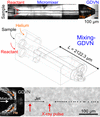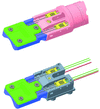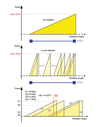issue contents
March 2022 issue

Cover illustration: Visualized XEOL mapping of Eu-doped BaAl2O4 at different emission wavelengths, see Wu, Lin, Chen, Fu, Huang, Lee, Chen, Yin, Huang, Tang and Lin, pages 456–461. The Taiwan Photon Source 23A X-ray nanoprobe has the significant characterization ability for unravelling the emission mechanisms of phosphor materials.
facility information
actinide physics and chemistry
Open  access
access
 access
accessThe study provides insight into the formation of thorium dioxide nanoparticles in solution using small-angle X-ray scattering.
Open  access
access
 access
accessNew experimental EXAFS results for PuO2 and CeO2 nanoparticles in the size range of 2 nm were compared with published data for other lanthanide and actinide dioxides. A conceptual core-shell model with a calculated effective coordination number is proposed to fit the changes in EXAFS.
Open  access
access
 access
accessUC and UMeC2 (Me = Fe, Zr, Mo) carbides were studied by the high-energy-resolution fluorescence detected X-ray absorption technique at the U M4 and L3 edges. The data were analyzed using the Anderson impurity model.
Open  access
access
 access
accessMultiple EXAFS LIII-edge spectra of U(VI) model compounds were recorded at the STM beamline of KISI-Kurchatov (Moscow, Russia). The distinct parameters obtained for the U(VI) local structure were used to analyze the sample of radioactively contaminated soil.
Open  access
access
 access
accessX-ray absorption spectroscopy was used to probe the interactions between an octadentate hydroxypyridinone chelator and two transuranic elements in microgram quantities – plutonium and berkelium – within buffered solutions. Despite the precedence for chelation-driven stabilization of the tetravalent oxidation state of actinides with this ligand, in situ reductive decomposition yielded plutonium(III) and berkelium(III) coordination complexes.
research papers
Open  access
access
 access
accessStudying electron- and X-ray-induced electron cascades in solids is essential for various research areas at free-electron laser facilities, such as X-ray imaging, crystallography, pulse diagnostics or X-ray-induced damage. To better understand the fundamental factors that define the duration and spatial size of such cascades, this work investigates the electron propagation in ten solids relevant for the applications of X-ray lasers. Using classical Monte Carlo simulation in the atomic approximation, the dependence of the cascade size on the incident electron or photon energy and on the target parameters is studied.
Open  access
access
 access
accessPresented here are 3D printed sample delivery devices for precise control over fluids and the generation of micrometre-sized gas-focused liquid jets, high-viscosity streams and near-monodisperse droplets suitable for X-ray scattering experiments on X-ray free-electron laser (XFEL) instruments.
Open  access
access
 access
accessA method that utilizes the recent external light from high-harmonic generation (HHG) to coherent light at shorter wavelength is proposed. Numerical simulations with parameters of a diffraction-limited storage ring demonstrate the generation of coherent pulse trains with photon energy as high as 2 keV, pulse duration as short as ∼10 fs and high peak brightness directly from an HHG source at 13 nm.
Open  access
access
 access
accessTransmission properties and diffraction patterns generated by synchrotron radiation at the exit of an assembled couple of microchannel plates (MCPs) are inivestigated. A theoretical model to simulate the patterns and properties of the soft X-ray beam emerging from this couple of MCPs is presented and discussed.
Open  access
access
 access
accessA novel welded photon absorber with a total length of 600 mm has been successfully designed and manufactured, and will be applicable in the highest-heat-load front-end in the Shanghai Synchrotron Radiation Facility Phase-II beamline project.
Open  access
access
 access
accessDiffraction losses (glitches) at certain energies of the X-ray beam, transmitted through a single crystal, can be used for lattice parameters determination as well as for calibrating the monochromator (absolute pitch angle and the unit-cell parameter).
Open  access
access
 access
accessThe heat-load effects on cryo-cooled Si crystals in synchrotron beamlines are investigated.
Open  access
access
 access
accessA new theoretical approach for computing the focusing performance of X-ray optics with circularly symmetry shape was developed. Greyscale electron beam lithography was applied to generate 3D kinoform zones in Au for hard X-rays for the first time. The novel trapezoid kinoform zone plate lens demonstrates significantly high diffraction efficiency well beyond that of conventional X-ray optics.
Open  access
access
 access
accessProcedures for fully automated X-ray energy changes at undulator-based synchrotron radiation beamlines with Kirkpatrick–Baez focusing mirrors or a long transfocator consisting of compound refractive lenses are presented. The procedures maintain beam intensity after the monochromator, beam position at the sample, beam attenuation, and the beam focusing distance.
Open  access
access
 access
accessBeamline BL-13B of the Photon Factory and the end-station have been upgraded, enabling microscopic XPS, XAS, and ARPES measurements with a spatial resolution that is comparable with the size of the focused beam. Beam profile evaluation and experimental demonstration of microscopic measurements are presented.
Open  access
access
 access
accessThe operation of the P61B endstation large-volume press and optics of P61 are reviewed. The instrumentation at P61B, including the large-volume press, detection systems and data acquisition for in situ high-pressure experiments are described.
Open  access
access
 access
accessA polycrystalline diamond detector for XAFS measurement has been fabricated. Its volume is 2947 times smaller than a routine ion-chamber.
Open  access
access
 access
accessThe development of an in situ gas/heating cell for X-ray nanoprobe studies is presented. The capabilities are demonstrated by an investigation of the redox behaviour of supported Pt nanoparticles on ceria.
Open  access
access
 access
accessThe implementation of microfluidic-based wedged-serial protein crystallography at PROXIMA-1 opens new possibilities for in situ data collection experiments with low sample consumption.
Open  access
access
 access
accessDiffuse X-ray scattering from polished silicon: application of the distorted wave Born approximation
Measurements of diffuse X-ray scattering from polished silicon were fit. The fits employed autocorrelation functions obtained from direct metrology of the surface roughness.
Open  access
access
 access
accessIt is anticipated that X-ray nanoprobes will open new avenues with significant characterization ability for unravelling the emission mechanisms of phosphor materials.
Open  access
access
 access
accessExperimental and computational studies of wigglers on low-emittance storage rings are reported. EXAFS spectra for possible distortions originating from the source imperfection are also examined. It is concluded that wigglers are still an appropriate class of insertion devices, also on low-emittance synchrotrons.
Open  access
access
 access
accessThis work describes an experimental method in tackling the self-absorption effect encountered in fluorescence X-ray absorption spectroscopy and its application to surface and subsurface.
Open  access
access
 access
accessThe implementation of high-speed ptychography on the Australian Synchrotron XFM beamline in presented. It includes a free-run data collection mode where dead time is eliminated and scan time is optimized. This data collection mode is compatible with fast-scanning X-ray fluorescence mapping with extremely high data acquisition rates over large areas, demonstrated at up to 140 µm2 s−1 with 13× spatial resolution enhancement compared with the beam size.
Open  access
access
 access
accessA rapid phase symmetry method for finding the center of rotation in tomographic data using two images located 180° ± Δθ apart is introduced. The method is more robust against photon noise than image correlation methods, and shows good tolerance to Δθ ranging up to several degrees.
Open  access
access
 access
accessEarly root carious lesions require an optimal amount of both free fluoride and calcium ions in the oral environment to initiate a hydroxyapatite remineralization on root dentin. This study elucidates the role of fluoride and calcium to maintain the abundance of hydroxyapatite on acid-challenged root dentin with a novel approach – using synchrotron radiation.
Open  access
access
 access
accessA custom wide-field lens and a new-generation megapixel camera enabled micro-CT scanning over a 3.5 mm × 5 mm field of view at 1 µm resolution/0.5 µm pixel size at Lawrence Berkeley Laboratory's Advanced Light Source and Argonne National Laboratory's Advanced Photon Source using a phantom with micron-scale features. This novel combination of resolution and field of view was designed for broad applicability to any setting in which micron-scale structures need to be characterized comprehensively in three dimensions over mm to cm.
Open  access
access
 access
accessA new environmental cell for simultaneous in situ dynamic X-ray imaging and measuring acoustic properties of geological samples is presented. The cell helps studying physical/chemical processes in geomaterials and their influence on the mechanical properties.
Open  access
access
 access
accessAn in situ corner bending test under a high thermal gradient is followed by both computed tomography and thermography. Experimental procedure, image processing and preliminary conclusion are presented.
beamlines
Open  access
access
 access
accessThe Materials Science (MS) beamline at SESAME, dedicated to the X-ray powder diffraction technique, started its operational phase in December 2020. A detailed description of the beamline components and the experimental characterization of the main instrumental parameters are presented.
Open  access
access
 access
accessInstrumentation and software for supporting microbeam structural mapping at the LiX beamline are presented.
Open  access
access
 access
accessThe implementation of a new, fully automated X-ray total scattering system on beamline BL04B2 at SPring-8 is described.
Open  access
access
 access
accessA new experimental setup for millisecond time-resolved X-ray solution scattering has been developed and commissioned at the CoSAXS beamline at the MAX IV synchrotron. Results from T-jump experiments induced by infrared laser pulses in lysozyme in solution are presented for validation.
Open  access
access
 access
accessThe design of the resonant inelastic X-ray scattering beamline at Diamond Light Source, I21, is presented. X-ray commissioning results are shown and compared with the optical simulations.
Open  access
access
 access
accessID23-2 is a microfocus synchrotron beamline dedicated to macromolcular crystallography at the ESRF-EBS.
PDB reference: 7qgf
obituaries
Open  access
access
 access
accessaddenda and errata
Open  access
access
 access
accessA figure in the article by Baba et al. [(2021), J. Synchrotron Rad. 28, 1284–1295] is corrected.
Open  access
access
 access
accessThe article by Léveillé et al. [(2022), J. Synchrotron Rad. 29, 103–110] is corrected.


 journal menu
journal menu





























































